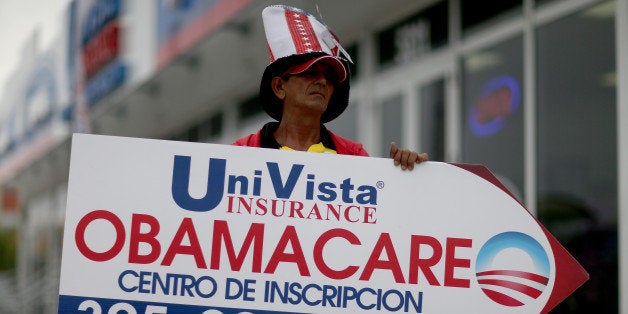
Premiums in the the Affordable Care Act’s new marketplaces rose more slowly in 2014 and 2015 than initial projections had suggested they would.
Don't bet on the same thing happening in 2016.
Insurers have already filed official proposals for next year's premiums and, in states where those filings are public, some large insurers are calling for substantial, double-digit increases over what they are charging this year.
These preliminary filings can be wildly misleading, not least because they represent a fraction of the states. Similar filings generated some hysterical headlines right about this time last year. Months later, with data from all the states available, researchers realized that, while premiums had gone up for some insurers in some states, they had gone down in others. The overall trend was actually much better than it had been historically. In the aggregate, that translated into an extra break for consumers, who pay the premiums, and for the federal government, which subsidizes less affluent consumers by offering them tax credits.
But, so far, the requests for increases this year appear bigger than last year’s. More importantly, the insurers' rationale may reveal something about how Obamacare is playing out in the states where information is available. According to the insurers, the people who signed up for their policies in 2014 are running up higher medical bills than the insurers had anticipated. While that could be the product of temporary factors, it could also mean healthy people aren’t lining up for coverage in the numbers that either the industry or outside analysts had hoped.
If that’s the case and if the trend continues, then insurers are going to have to start raising rates more quickly in the future, since carriers need premiums from healthy customers to offset the high costs of people with serious medical conditions. That will translate into higher costs for the government, as well as some consumers.
“So far, the health law pretty much matched or exceeded expectations, with millions of people covered and costs lower than projected,” Larry Levitt, senior vice president at the Henry J. Kaiser Family Foundation, told The Huffington Post. “Whether that continues hinges crucially on insuring more people, particularly those who are currently healthy.”
Reports of these large increases have appeared in several publications, including Investor’s Business Daily, The Washington Examiner and The Wall Street Journal, which conducted a comprehensive survey of rate proposals from a dozen states. Among the larger figures reported was a proposal from Tennessee’s BlueCross BlueShield, which is seeking increases in its plans that average 36.3 percent. In New Mexico, the average increase that Health Care Service Corporation has requested for its plans is 51.6 percent.
Those are some very large numbers, although they come with some very important asterisks. For one thing, in many states, officials who must review these rates are likely to reject them. In Maryland, for example, CareFirst, the state’s largest carrier, sought increases of between 23 and 30 percent for its plans last year. But the state's insurance regulators said no way, forcing the carrier to accept increases of just 9.8 to 16.2 percent.
This year’s requests from CareFirst look bigger than last year’s. By the time Maryland regulators are finished, however, the increases will likely be much smaller than what the company has officially sought. (It depends, in part, on whether Maryland's newly appointed insurance commissioner, a Republican and former insurance broker, is as aggressive as his predecessor was.) Meanwhile, Maryland consumers, like their counterparts around the country, also have choices. Cigna, Kaiser Permanente, and United all requested much lower increases than CareFirst did -- and Cigna is actually seeking a reduction.
As health care blogger Charles Gaba wrote at HealthInsurance.org this week, “When you see a shockingly high 2016 rate hike splashed across a headline, take it with a huge grain of salt. It may be accurate, or it may turn out to be much ado about nothing.”
The same variety that exists within states exists across them: Virginia’s largest carrier, Anthem, is seeking average increases of just 13.2 percent, according to the Journal. By contrast, the largest plans in Indiana and Connecticut have requested increases of just 3.8 and 2 percent, respectively. And even within specific markets, premiums will vary enormously from consumer to consumer, since most people who buy through the new Obamacare marketplaces are eligible for financial assistance. The amount of that assistance depends on two factors: the income of the person or family buying the coverage, and the prices of different plans relative to one another.
Still, the requests from insurers certainly matter -- partly because the more they end up charging, the more the federal government has to pay in order to subsidize the price for consumers who qualify for financial assistance. (Under the Affordable Care Act, tax credits for health insurance are available to households with annual incomes below four times the poverty line, which, this year, amounts to $97,000 for a family of four.)
So why might insurers be seeking bigger increases this year? One reason could be the normal and predictable competition among insurance plans jostling for market share, with larger plans more willing to shed customers and smaller plans eager to attract new ones. Len Nichols, director of the Center for Health Policy Research and Ethics at George Mason University, thinks these market dynamics are an important part of the story -- particularly since, overall, the trend in health care costs has been toward relatively moderate growth.
“Note how the largest proposed increases are from insurers with the largest market shares," Nichols said. "I can believe costs were higher than expected, but not thirty-plus percent higher. Health services cost trends are too low, and actuaries would have been fired over that big a miss. This could reflect dominant firms losing their fear of new competition, or making their peace with smaller market share but with higher margins.”
Another factor driving higher premiums could be anxiety over King v. Burwell, the lawsuit challenging the federal government’s authority to distribute health insurance tax credits in two-thirds of the states. The Supreme Court is likely to rule on the case around the end of June. If the court rules in favor of the plaintiffs, thereby cutting off financial assistance in those states, millions will drop their coverage because they will no longer be able to afford it. That will wreak havoc with insurance markets, and not all states have signaled that they will let carriers modify the rate filings for next year.
But the big question, and the one that will worry even staunch Obamacare defenders, is about the mix of customers -- whether insurers are attracting enough customers in relatively good health. It’s particularly salient right now because insurers are spooked by a new specialty drug, Sovaldi, that can treat hepatitis C, a disease that affects millions -- but costs $1,000 per pill and $84,000 per treatment. It also doesn’t help that some of the Affordable Care Act’s “shock absorbers,” designed to help insurers offset the cost of higher-than-expected medical expenses, will expire after next year.
Clare Krusing, a spokesperson for America’s Health Insurance Plans, the industry trade group, told the Journal that “This year, health plans have a full year of claims data to understand the health needs of the [health insurance] exchange population, and these enrollees are generally older and often managing multiple chronic conditions. Premiums reflect the rising cost of providing care to individuals and families, and the explosion in prescription and specialty drug prices is a significant factor.”
For now, nobody can really know what’s going on -- or, more importantly, what will happen in the future. Demand for medical services could taper off as newly insured people finish getting the exams and treatments they’d been postponing, which would suggest that the current surge in demand is a temporary phenomenon. Similarly, healthier people could come to the plans in greater numbers, as the system becomes more familiar and the penalty for remaining uninsured becomes more onerous. Or premiums could naturally settle at an affordable equilibrium -- perhaps with an assist from regulators, who sometimes, but not always, use the authority they have. (Insurers are making very good profits, so regulators would seem to have a case for challenging high rates.)
Or none of these things could happen, enrollment growth in the marketplaces could stall and premiums could end up higher than expected. The only sure thing right now is that the story about premiums will play out differently in different states, as well as over a long period of time.

